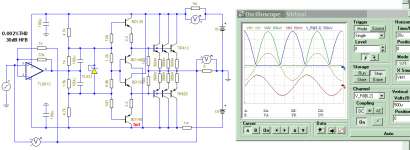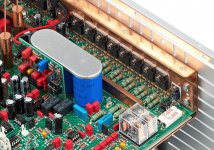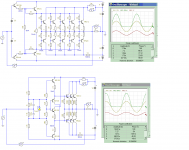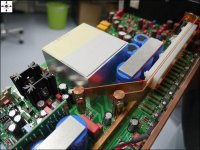Yes, long cable work like that, They using some small long cable tied together.
1.Soulution : Don't know what is inside, homemodder said equal with self's based with many bjt outputs (enriched class AB).
2.Technical Brain : Non switching OPS based (better than self's OPS) with balanced topology.
3.It must be your job to find the 3rd.
TBP OPS may better this way for stabler (may be).
Edit: I forgot there is BD139(bottom) also hot.
Got to add more two.Where's the list ....?
1.Soulution : Don't know what is inside, homemodder said equal with self's based with many bjt outputs (enriched class AB).
2.Technical Brain : Non switching OPS based (better than self's OPS) with balanced topology.
3.It must be your job to find the 3rd.
TBP OPS may better this way for stabler (may be).
Edit: I forgot there is BD139(bottom) also hot.
Attachments
Last edited:
Yes, long cable work like that, They using some small long cable tied together.
Got to add more two.
1.Soulution : Don't know what is inside, homemodder said equal with self's based with many bjt outputs (enriched class AB).
2.Technical Brain : Non switching OPS based (better than self's OPS) with balanced topology.
3.It must be your job to find the 3rd.
TBP OPS may better this way for stabler (may be).
Edit: I forgot there is BD139(bottom) also hot.
I think you misunderstood my post, I said the performance of soulution could be attained with a self based circuit, Im dont know the exact topology used.
But mind you they say no Global feedback, but I have doubts about that. They say it has input buffer, so Im thinking of the possibilty of input buffer then say a self topology and say it has no global feedback which would be true in the form that the feedback wont be around the buffer too, so in the strickest sense they are right but its decieving, Ive seen a case of a manufacturer do this as the term no global feedback seems to be in vogue at the moment.
Yes sorry , I mean like that. I said equal.I think you misunderstood my post, I said the performance of soulution could be attained with a self based circuit, Im dont know the exact topology used.
But mind you they say no Global feedback, but I have doubts about that. They say it has input buffer, so Im thinking of the possibilty of input buffer then say a self topology and say it has no global feedback which would be true in the form that the feedback wont be around the buffer too, so in the strickest sense they are right but its decieving, Ive seen a case of a manufacturer do this as the term no global feedback seems to be in vogue at the moment.
Also I agree that measured Low THD at various load is impossible without NFB, (in term that local feedback like in EC counted as NFB)
Lists That collected from this threads (previous posts):
post#8 by Tajzmaj
*Phase Linear 700b
Crown DC300
Quad 405
*McIntosh MC-3500
McIntosh MI-350
post#10 by ingenieus
Dynaco ST-70
Krell KSA-100
*Mark Levinson ML2
*Audio Research Reference 610T
Conrad Johnson Premier One
Carver Silver Sevens
Audio Note Ongaku
Cary CAD-805
post#25 by ingenious
NAD 3020
Naim NAP250
Krell KSA50
post#26 by jezz
Leak Stereo 20
Quad II
Radford STA25
Quad 303
A & R Cambridge A60
EAR 519
Musical Fidelity A370
Sugden A21
post#28 by VACS
Dynamic Precision A1s
post#32 by tiefbassuebertr
Aleph 1.2
Krell MRA
*XA200.5
XA.5 Series
*Halcro DM78
Sumo The Nine
TEM 3200
Yamaha MX-10000
post#51 by Ricdelros
McIntosh Mc275
post#53 by gaetan888
Denon PMA-700
post#57 by tommy thong
Marantz model Fifteen
Goldmund Mimesis 39
Jadis DA88 for tubey Amp
post#62 by tvrgeek
Arragon 2002
Rotel 840
Bryston 2B
post#69 by wahab
Ferguson IIRC
JVC AX 1/../9 serie
post#73 by geraldfryjr
Sansui G9000 receiver
post#81 by tiefbassuebertr
Plinius Audio SA-103
post#87 by BTW
Spectral DMA100
post#90 by vdsvicky
Pioneer SA-900 and SA-9100
post#90 by TheShaman
*LAMM industries
*Soulution 710
post#145 by lanchie
Bryston B60
Marantz 2238B.
post#166 by homemodder
*Technical Brain TBP-Zero amp
post#200 by VladimirK BAabo BP-1 Mk-II (similar soulution 700)
* my best candidate.
post#8 by Tajzmaj
*Phase Linear 700b
Crown DC300
Quad 405
*McIntosh MC-3500
McIntosh MI-350
post#10 by ingenieus
Dynaco ST-70
Krell KSA-100
*Mark Levinson ML2
*Audio Research Reference 610T
Conrad Johnson Premier One
Carver Silver Sevens
Audio Note Ongaku
Cary CAD-805
post#25 by ingenious
NAD 3020
Naim NAP250
Krell KSA50
post#26 by jezz
Leak Stereo 20
Quad II
Radford STA25
Quad 303
A & R Cambridge A60
EAR 519
Musical Fidelity A370
Sugden A21
post#28 by VACS
Dynamic Precision A1s
post#32 by tiefbassuebertr
Aleph 1.2
Krell MRA
*XA200.5
XA.5 Series
*Halcro DM78
Sumo The Nine
TEM 3200
Yamaha MX-10000
post#51 by Ricdelros
McIntosh Mc275
post#53 by gaetan888
Denon PMA-700
post#57 by tommy thong
Marantz model Fifteen
Goldmund Mimesis 39
Jadis DA88 for tubey Amp
post#62 by tvrgeek
Arragon 2002
Rotel 840
Bryston 2B
post#69 by wahab
Ferguson IIRC
JVC AX 1/../9 serie
post#73 by geraldfryjr
Sansui G9000 receiver
post#81 by tiefbassuebertr
Plinius Audio SA-103
post#87 by BTW
Spectral DMA100
post#90 by vdsvicky
Pioneer SA-900 and SA-9100
post#90 by TheShaman
*LAMM industries
*Soulution 710
post#145 by lanchie
Bryston B60
Marantz 2238B.
post#166 by homemodder
*Technical Brain TBP-Zero amp
post#200 by VladimirK BAabo BP-1 Mk-II (similar soulution 700)
* my best candidate.
Last edited:
Lists That collected from this threads (previous posts):
post#8 by Tajzmaj
*Phase Linear 700b
Crown DC300
Quad 405
*McIntosh MC-3500
McIntosh MI-350
post#10 by ingenieus
Dynaco ST-70
*Krell KSA-100
*Mark Levinson ML2
*Audio Research Reference 610T
Conrad Johnson Premier One
Carver Silver Sevens
Audio Note Ongaku
Cary CAD-805
post#25 by ingenious
NAD 3020
Naim NAP250
Krell KSA50
post#26 by jezz
Leak Stereo 20
Quad II
Radford STA25
Quad 303
A & R Cambridge A60
EAR 519
Musical Fidelity A370
Sugden A21
post#28 by VACS
Dynamic Precision A1s
post#32 by tiefbassuebertr
Aleph 1.2
Krell MRA
*XA200.5
XA.5 Series
*Halcro DM78
Sumo The Nine
TEM 3200
Yamaha MX-10000
post#51 by Ricdelros
McIntosh Mc275
post#53 by gaetan888
Denon PMA-700
post#57 by tommy thong
Marantz model Fifteen
Goldmund Mimesis 39
Jadis DA88 for tubey Amp
post#62 by tvrgeek
Arragon 2002
Rotel 840
Bryston 2B
post#69 by wahab
Ferguson IIRC
JVC AX 1/../9 serie
post#73 by geraldfryjr
Sansui G9000 receiver
post#81 by tiefbassuebertr
Plinius Audio SA-103
post#87 by BTW
Spectral DMA100
post#90 by vdsvicky
Pioneer SA-900 and SA-9100
post#90 by TheShaman
*LAMM industries
*Soulution 710
post#145 by lanchie
Bryston B60
Marantz 2238B.
post#166 by homemodder
*Technical Brain TBP-Zero amp
post#200 by VladimirK BAabo BP-1 Mk-II (similar soulution 700)
* my best candidate.
the characterizing models I've heard. Unfortunately not all together, rather over a longer period of several years. And always at other loudspeakers. Consequently, I cannot make exact statements concerning the individual sonic character. But I think, I can say, that the models in thick font clearly outperform the underlined models, marked in cursive font.
An other vintage model (until now not mentioned here) with exceptionell sonic quality - especially for full range applications - is the Papworth, model TVA1 (Power Amp) and TVA 10 ( integrated amplifier, formerly Michaelson & Austin).
http://audio-nirvana.fortunecity.net/pag_eng/tvag.htm
http://ampslab.com/vintage_michaelsonaustin_tva1.htm
http://www.jogis-roehrenbude.de/Roe...Radio-Restauration/Knipschild_TVA-1/TVA-1.htm
http://amp8.com/vv-amp/michaell/tva-1-7.htm
http://ampslab.com/vintage_michaelsonaustin_tva10.htm
http://www.myav.com.tw/market/showthread.php?threadid=231865
http://124.150.130.98/market/printthread.php?threadid=231865
http://audio-heritage.jp/MICHAELSONandAUSTIN/amp/tva-10.html
Unlike the most other tube models the low frequency area by this models is clean and tight, independend of the kind of loudspeaker.
Last edited:
in thick font
Maybe if you took the Yamaha anniversary off.
I heard the CX-MX 10K combo at the High End show in the late '80s ('88 Düsseldorf maybe).
Build quality of the MX-10000 is superb, sound quality is marginal at best.
Plenty power amp models then that cost 1/6th to 1/4th, which sounded at least equal.
The CX-10000 model was a superb preamp, both in build and sound, though also very costly, compared to other brands. An Accuphase C280 was cheaper, but had a better phono stage.
Collectors items for suckers with DM30.000 to burn (DM35.000, including the HX-10000 phono).
Most of the audio mags agreed back then, save that POS magazine Hifi Vision.
(from the back of my head archive : Audio, August 1988, 80 Gesamtpunkte)
Last edited:
I had the chance to compare a few MC2 Audio amps directly with Phase Linear 700b, a Bryston whose model no I don't recall, Quad 520f, an Arcam integrated and a Harrison MosFet amp amongst others and to my ears the all MC2 models outperformed all others quite clearly.
I have not heard MC2s latest class D models but even I don't need 1700w/8Ohm or more at home! All other MC2 amps use the same audio circuitry but differ in PSUs and protection circuits.
I have not heard MC2s latest class D models but even I don't need 1700w/8Ohm or more at home! All other MC2 amps use the same audio circuitry but differ in PSUs and protection circuits.
Thanks tommy, that's make it clear.This is the Solutions 710 output stage and schematic. It uses low cost Sanken power transistors. I think the stage before the output stage is AR D-400 inspired.
So there is no feedback from OPS, Linearity just coming from reducing its triple EF gain with resistors (simplest local feedback, but it is OK to call it no feedback), then linear current fed into the OPS by opamp based current source.
But, is there really no feedback? because their DF claime 10000. I am going to look at it.
AR D400:
http://peufeu.free.fr/audio/schemas/Audio_Research_D400a.JPG
@Charles,
Sorry my mistake, I just pick them up too fast and not noticing your fast MC2.
Last edited:
OOps, I am doing mistake in TPB zero, its asymetrical driver current isn't make the OP transistor to not switching, but only help in forward and reverse linearization, I am just think where its non switching coming from and doesn't find any reason. But just found some my measuring mistakes.
So TPB Zero is not non-switching OPS, but only linearized. <0.3%THD without feedback in voltage mode. Could reach 0.1% with higher current driver.
This is both TPB and soulution plot. I tried to linearize soulution with resistors, not reaching any good results with typical BJT (TIP41/42) There may be the error correction coming from inputs (pre EC) or just choosing linear BJT's.

So TPB Zero is not non-switching OPS, but only linearized. <0.3%THD without feedback in voltage mode. Could reach 0.1% with higher current driver.
This is both TPB and soulution plot. I tried to linearize soulution with resistors, not reaching any good results with typical BJT (TIP41/42) There may be the error correction coming from inputs (pre EC) or just choosing linear BJT's.
Attachments
badly built British gear
I completely agree here. I owned a AR Cambridge A60 (I think). It sounded wonderful, but had a power supply design that was inherently bad. It burnt up as I watched it idle (no speaker load, no audio signal). Just powered it up and ....Poof! I think the Audiolab 8000A was my first good experience with British gear that was well built (cheap case, well built guts). It had a good MC stage built in too!
In the '70s & '80s in Europe it was all japanese and Revox.
British amps were underpowered and badly built.
I completely agree here. I owned a AR Cambridge A60 (I think). It sounded wonderful, but had a power supply design that was inherently bad. It burnt up as I watched it idle (no speaker load, no audio signal). Just powered it up and ....Poof! I think the Audiolab 8000A was my first good experience with British gear that was well built (cheap case, well built guts). It had a good MC stage built in too!
Are you influenced by the impact of DF on sound quality? Which came first in your experience? Did the Threshold sound great before or after you learnt about its DF; which at a 130 is fully satisfactory?. If I believe a priori that a high DF makes for a great sounding amp, my logical mind can't help but conclude that an amp with a lower DF does sound less great!
Hi Guys.......
Read this on the FM Acoustics Resolution FM 1811 Stereo Power Amp
"A FEW SPECIFICATIONS
Minimum Power Output:
Per channel, both channels operating with continuous music or continuously repetitive toneburst:
1000 Wpeak into 8 Ohms
1800 Wpeak into 4 Ohms
3200 Wpeak into 2 Ohms
500 WRMS into 8 Ohms
900 WRMS into 4 Ohms
1600 WRMS into 2 Ohms
(Just for comparisons' sake: the impulse power is more than 4500W per channel...).
Max. Output Voltage: 180 V pp.
Max. Output Current:
Absolutely unlimited peak current (over 550A). More than 80A continuous per channel allows the FM 1811 to drive any known load with optimal fidelity. No fuses, absolutely no form of current, voltage or any other kind of limiting are employed.
Distortion:
Average distortion: 0,005% THD
Gain: 30dB
Risetime at Full Power -3dB: 3 us
Hum and Noise: (20Hz-20kHz).
Below full power typically: -115 dB
Min. unweighted: better than -100 dB
Input:
Input: Proprietary, electronically balanced, discrete enhanced class A circuitry, floating ground, non-inverting or inverting mode. Optimal performance with either balanced or unbalanced (single-ended) sources. Unbalanced sources are automatically balanced right at the inputs of the FM 1811.
Input Stage Common Mode Rejection:
105 dB typically, better than 95 dB at 50Hz even better at other frequencies.
Maximum Input Level:
+20 dBm (7,75 VRMS)
Load Impedance: No minimum impedance. Designed for below 1 Ohm to above 10’000 Ohm systems. Can drive any speaker impedance - dynamic, electrostatic, ribbon, planar etc. - without any compression, limiting or any other negative effects on the audio signal. Despite this, the amplifier is fully protected against short circuits and all other adverse conditions via a unique onboard system that continuously surveys all important parameters.
Protection:
Unique protection systems proprietary to
FM ACOUSTICS protect against adverse conditions such as short circuit, open circuit, HF Oscillation, RF interference, +DC and -DC offset, fan activity, temperature, blocked or dirty fan filters, damage to the protection system itself, etc.
Chassis Resonance Damping:
New dual chassis design effectively isolates sensitive electronic and mechanical components from potential negative influences such as induced resonances. Mechanical resonance damping on panels is employed. The whole chassis including cover, transformer mounting, transformer leaves, side panels, capacitor mounting etc. use anti-resonance technology.
Average Life Expectancy:
At 25oC ambient temperature, medium power, 10h/day, 365 days/year: 38 years.
Power Consumption:
At idle: 200 WRMS
At 30% power: 1400 WRMS
At full power: 3600 WRMS
With dynamic signals: 10000 Wpeak repetitive
Mains Supply Requirement:
No mains voltage drop when supplying:
25A continuous, 100Ap at 110V - 120V
12.5A continuous, 50 Ap at 110V - 120V
Burn-in Time at Factory:
Minimum 100 hours (500 thermal cycles)
Vibration Test at Factory:
Minimum 60 minutes (50’000 vibration cycles)
Output Connectors (on FORCELINES):
FORCEPLUG 200, ultra low-loss high-performance connectors.
Continuous current handling = 200A,1200Ap FORCELINES 3 required.
Spare Parts Availability:
Guaranteed available for a minimum of 10 years. Ex stock availability of 99% of all individual parts.
Weight: Only 45 kg net 50 kg packed
Dimensions:
430 mm wide
260 mm high
550 mm deep "s
......and weep!
Read this on the FM Acoustics Resolution FM 1811 Stereo Power Amp
"A FEW SPECIFICATIONS
Minimum Power Output:
Per channel, both channels operating with continuous music or continuously repetitive toneburst:
1000 Wpeak into 8 Ohms
1800 Wpeak into 4 Ohms
3200 Wpeak into 2 Ohms
500 WRMS into 8 Ohms
900 WRMS into 4 Ohms
1600 WRMS into 2 Ohms
(Just for comparisons' sake: the impulse power is more than 4500W per channel...).
Max. Output Voltage: 180 V pp.
Max. Output Current:
Absolutely unlimited peak current (over 550A). More than 80A continuous per channel allows the FM 1811 to drive any known load with optimal fidelity. No fuses, absolutely no form of current, voltage or any other kind of limiting are employed.
Distortion:
Average distortion: 0,005% THD
Gain: 30dB
Risetime at Full Power -3dB: 3 us
Hum and Noise: (20Hz-20kHz).
Below full power typically: -115 dB
Min. unweighted: better than -100 dB
Input:
Input: Proprietary, electronically balanced, discrete enhanced class A circuitry, floating ground, non-inverting or inverting mode. Optimal performance with either balanced or unbalanced (single-ended) sources. Unbalanced sources are automatically balanced right at the inputs of the FM 1811.
Input Stage Common Mode Rejection:
105 dB typically, better than 95 dB at 50Hz even better at other frequencies.
Maximum Input Level:
+20 dBm (7,75 VRMS)
Load Impedance: No minimum impedance. Designed for below 1 Ohm to above 10’000 Ohm systems. Can drive any speaker impedance - dynamic, electrostatic, ribbon, planar etc. - without any compression, limiting or any other negative effects on the audio signal. Despite this, the amplifier is fully protected against short circuits and all other adverse conditions via a unique onboard system that continuously surveys all important parameters.
Protection:
Unique protection systems proprietary to
FM ACOUSTICS protect against adverse conditions such as short circuit, open circuit, HF Oscillation, RF interference, +DC and -DC offset, fan activity, temperature, blocked or dirty fan filters, damage to the protection system itself, etc.
Chassis Resonance Damping:
New dual chassis design effectively isolates sensitive electronic and mechanical components from potential negative influences such as induced resonances. Mechanical resonance damping on panels is employed. The whole chassis including cover, transformer mounting, transformer leaves, side panels, capacitor mounting etc. use anti-resonance technology.
Average Life Expectancy:
At 25oC ambient temperature, medium power, 10h/day, 365 days/year: 38 years.
Power Consumption:
At idle: 200 WRMS
At 30% power: 1400 WRMS
At full power: 3600 WRMS
With dynamic signals: 10000 Wpeak repetitive
Mains Supply Requirement:
No mains voltage drop when supplying:
25A continuous, 100Ap at 110V - 120V
12.5A continuous, 50 Ap at 110V - 120V
Burn-in Time at Factory:
Minimum 100 hours (500 thermal cycles)
Vibration Test at Factory:
Minimum 60 minutes (50’000 vibration cycles)
Output Connectors (on FORCELINES):
FORCEPLUG 200, ultra low-loss high-performance connectors.
Continuous current handling = 200A,1200Ap FORCELINES 3 required.
Spare Parts Availability:
Guaranteed available for a minimum of 10 years. Ex stock availability of 99% of all individual parts.
Weight: Only 45 kg net 50 kg packed
Dimensions:
430 mm wide
260 mm high
550 mm deep "s
......and weep!
The Soulution amplifier uses a "home made" capacitor across the output terminals. I suppose the benefit of this design is to have a non inductive capacitor and to stabilize the amplifier under different load conditions.
Where are you seeing an output Shunting cap..
Manny huber makes great amplifiers , 3 db Dynamic headroom ....
- Status
- This old topic is closed. If you want to reopen this topic, contact a moderator using the "Report Post" button.
- Home
- Amplifiers
- Solid State
- List of the best sounding amplifiers




